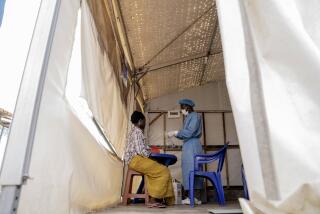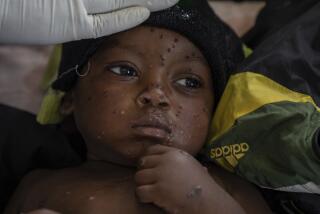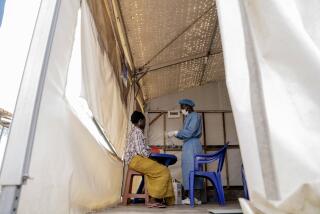Will monkeypox be the next smallpox?
Most vertebrate animal species have some sort of poxvirus capable of causing severe illness. These ancient pathogens have evolved within and among vertebrates since the dawn of life. In one of public health’s greatest triumphs, our own orthopox virus — smallpox, or Variola — was eradicated by 1980. Because chickenpox isn’t a true poxvirus, humans don’t have a poxvirus of their own anymore.
Now, however, some researchers are concerned that another orthopox virus, monkeypox, may be adapting to fill the void. Currently, monkeypox can spread to humans fairly easily if they come into contact with an infected animal. It doesn’t always spread from human to human. But that could change.
There are two distinct genetic lines of monkeypox. The less severe West African strain entered the United States in 2003 in the body of an infected Gambian pouched rat. It spread in a pet store to dormice and to caged prairie dogs, and eventually caused 81 human infections, none of them serious and none of which spread. The far deadlier Congo basin strain causes a disease that is “virtually indistinguishable” from typical smallpox, says virologist Mark Buller of St. Louis University.
In the Congo basin, an area crossed and re-crossed by battling armies in the Democratic Republic of Congo’s long civil war, people are suffering, almost out of sight of the rest of the world, from a monkeypox strain that causes disfiguring rashes, headaches, fevers and sometimes blindness. About 10% of those affected die — a rate approximating the African death rate from smallpox.
Worse, monkeypox in the Congo basin is evolving so that it can spread from one person to another. A study in a hospital setting documented six generations of monkeypox transmission.
This is the way pathogens jump species. Sickening new hosts is just the first step. The germ then has to adapt in ways that allow it to evade the immune system of the new species and spread within it. This process takes time. But as evolutionary biologist Paul W. Ewald of the University of Louisville says, once a germ has a tiny foothold in a new species, we can expect it to get better and better at spreading.
“Those variants better at spreading will win out over time,” says Ewald. “This is the process that adapts the virus to humans.”
Humans have a strong weapon against monkeypox: The live attenuated vaccine virus used to eradicate smallpox also protects against monkeypox. But since the eradication of smallpox, humans no longer receive the vaccine, and that has meant that the number of people susceptible to monkeypox has grown dramatically.
According to a recent report by Anne W. Rimoin of UCLA and colleagues, the end of smallpox vaccination has meant the explosion of acute Congo basin monkeypox. Infections have increased 20-fold since the 1980s. And the increase has come in a region where public health has little foothold and people are desperate.
“People are worse off now than they were then,” says Rimoin. “It’s a complete collapse of the infrastructure.”
The stressed population is less resistant to disease. Also, according to Rimoin, the people are “almost completely dependent” for protein on “bush meat” — monkeys, rodents and other wild things that can carry monkeypox. Most cases of the disease now arise directly from contact with wild animals. But, as Rimoin notes, “each new infection provides the virus with a new opportunity to evolve to a more contagious variant capable of sustained person-to-person transmission.”
The thought of a new human poxvirus evolving under our noses is unsettling to say the least, though Rimoin thinks such an adaptation would likely take centuries, because poxviruses are less prone to mutations than viruses such as influenza.
But not all researchers agree. Virologist Earl Brown of the University of Ottawa agrees that poxviruses are more stable, but he isn’t sure that will protect us. “Once you have a big population of viruses and the mutants are there,” he says, “then you have the opportunity to change viruses if the environment selects for them.” And Ewald says the process takes only as long as it takes the virus to adapt to humans, which could happen rapidly — in a few years or even a few months.
The U.S. has a stockpile of smallpox vaccine to protect us in the unlikely event of a smallpox terrorist attack. So why don’t we use some of it to protect people threatened by monkeypox in the Congo? Rimoin says that people in the region are likely to be immuno-compromised because of malnourishment, stress and protein deficiency. Because the vaccine is a live, though weakened, virus, it could infect and even kill people with severely compromised immune systems. The World Health Organization and Congo’s Ministry of Health have both decided that the risks of the vaccine, plus its considerable expense, outweigh the benefits of protection against monkeypox.
Maybe. But the danger is real. The big jump to sustained spread of monkeypox hasn’t happened, perhaps because monkeypox outbreaks happen deep in the bush, in villages that are isolated. But we don’t really know what’s happening in all parts of the war-shattered country. Researchers are united in their insistence that surveillance in the Congo is crucial, no matter how difficult it is to access the remote places haunted by monkeypox.
There isn’t much money for surveillance, or much concern about a disease that seems remote to us, even though we were nicked once by a brief encounter with a milder strain. But we are all inhabitants of a single planet, and the evolution of a new form of human poxvirus, remote and unlikely though it still seems, has the power to affect us all.
Wendy Orent is the author of “Plague: The Mysterious Past and Terrifying Future of the World’s Most Dangerous Disease.”






